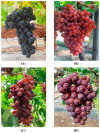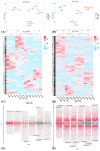Comparative Omics Analysis of Four Grape Varieties and Exploration of Their Anthocyanin Synthesis Mechanisms
- PMID: 40870003
- PMCID: PMC12386037
- DOI: 10.3390/genes16080955
Comparative Omics Analysis of Four Grape Varieties and Exploration of Their Anthocyanin Synthesis Mechanisms
Abstract
Background: Vitis vinifera L. exhibits diverse varietal traits influencing fruit quality and stress tolerance. The summer black grape (Xiahei), known for its superior tolerance to abiotic stress and intense pigmentation, was hypothesized to possess distinct metabolic and genetic profiles, particularly in flavonoid and anthocyanin biosynthesis. This study aimed to elucidate the metabolic and molecular basis underlying these phenotypic traits by comparing carbohydrate composition and metabolomic and transcriptomic profiles of four grape varieties (summer black, flame seedless, black grape, and red milk). Methods: Grapes were consistently sampled five days after full maturity, and metabolites were analyzed using UPLC-MS/MS and GC-MS, while transcriptome analysis employed RNA sequencing followed by qRT-PCR validation. Results: The results demonstrated that carbohydrate content was similar among all grape varieties, whereas the summer black grape showed significantly higher levels of flavonoids, particularly anthocyanins such as delphinidin-3-O-glucoside, cyanidin-3-O-glucoside, and pelargonidin-3-O-glucoside. Metabolomic analyses revealed substantial enrichment of metabolites involved in flavonoid biosynthesis pathways, in agreement with transcriptomic data showing significant upregulation of key regulatory genes (CHS, DFR, and ANS) specific to anthocyanin biosynthesis. These findings suggest that the pronounced anthocyanin accumulation in summer black grape contributes to its distinctive dark pigmentation and enhanced resistance to abiotic stresses compared to other varieties. Conclusion: This study provides novel insights into the molecular and metabolic mechanisms driving anthocyanin accumulation in summer black grapes, which could inform future breeding programs aimed at improving grape resilience.
Keywords: Vitis vinifera L.; anthocyanin biosynthesis; gene expression; metabolomics; transcriptomics.
Conflict of interest statement
The authors declare that they have no known competing financial interests or personal relationships that could have appeared to influence the work reported in this paper.
Figures






Similar articles
-
Study on the dynamics of fruits color related genes and metabolites during the fruit development of Zanthoxylum bungeanum 'Hanyuan'.BMC Plant Biol. 2025 Jul 26;25(1):960. doi: 10.1186/s12870-025-06962-4. BMC Plant Biol. 2025. PMID: 40713503 Free PMC article.
-
Integrated omics and functional insights into BjMYB90-mediated regulation of BjGSTF12 for enhanced anthocyanin biosynthesis in mustard (Brassica juncea).Plant Cell Rep. 2025 Jul 2;44(7):166. doi: 10.1007/s00299-025-03542-6. Plant Cell Rep. 2025. PMID: 40601061
-
Metabolome and transcriptome profiling reveals light-induced anthocyanin biosynthesis and anthocyanin-related key transcription factors in Yam (Dioscorea Alata L.).BMC Plant Biol. 2025 May 30;25(1):729. doi: 10.1186/s12870-025-06738-w. BMC Plant Biol. 2025. PMID: 40442608 Free PMC article.
-
Occurrence, Biosynthesis, and Health Benefits of Anthocyanins in Rice and Barley.Int J Mol Sci. 2025 Jun 27;26(13):6225. doi: 10.3390/ijms26136225. Int J Mol Sci. 2025. PMID: 40649998 Free PMC article. Review.
-
A comprehensive review of the transcriptomic and metabolic responses of grapevines to arbuscular mycorrhizal fungi.Planta. 2025 Jul 17;262(3):58. doi: 10.1007/s00425-025-04771-5. Planta. 2025. PMID: 40676374 Review.
References
-
- Restani P., Fradera U., Ruf J.-C., Stockley C., Teissedre P.-L., Biella S., Colombo F., Lorenzo C.D. Grapes and their derivatives in modulation of cognitive decline: A critical review of epidemiological and randomized-controlled trials in humans. Crit. Rev. Food Sci. Nutr. 2021;61:566–576. doi: 10.1080/10408398.2020.1740644. - DOI - PubMed
-
- Yan L., Xin-Ming L., Ting C., Chao-Yue G., Wei-Xiong H., Sheng-Hua C. Early-maturing Cultivation of Xiahei Grapes. Fujian J. Agric. Sci. 2014;29:966–969.
Publication types
MeSH terms
Substances
Grants and funding
LinkOut - more resources
Full Text Sources
Miscellaneous

